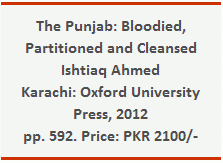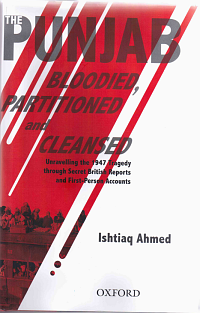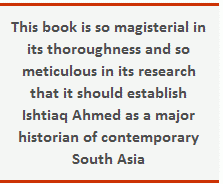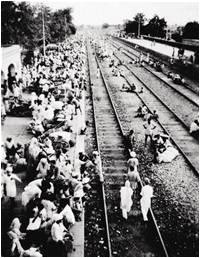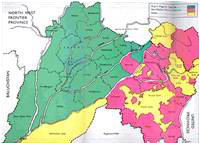Chain of events
In Stage Two, Ishtiaq Ahmed reaches the conclusion that the roughs (badmashes) of Lahore and Amritsar, who were mostly Muslims, had a predominant role in the carnage. The roughs of Amritsar sent bangles to their counterparts of Lahore, signifying that they were not avenging attacks on Muslims in the Sikh areas. This resulted in a quantum leap in violence against the non-Muslims in Lahore. The fire at Shahalami Gate of June in which the Hindus were harmed on such a massive scale left them completely disillusioned. After this they started leaving for India en masse. The role of some officials, including police and judicial functionaries, has been described probably for the first time by this author.
In the Eastern Punjab the Sikh armed groups started attacking Muslims even from early in the year, but the communal cleansing started only in August when the Sikh leadership knew they would lose by the division of the Punjab without accommodating their demands. Here the atrocities of Rawalpindi and Lahore were repeated on an even bigger scale: murder, arson, rape and pillage were reported on a staggering scale. Here too some functionaries of the state aided and abetted the attackers and even some of the rulers of the Punjab princely states such as the Maharajah of Kapurthala and the Maharajah of Patiala abetted the violence against Muslims.
The most important contribution of the author is that he maintains his scholarly objectivity in a subject in which his own emotions are obviously deeply involved. He reaches the conclusion that there was no plan by the Muslims in general or the Muslim League in particular to cleanse Pakistan of non-Muslims. However, in the case of Sikhs, the author concludes that some Sikh leaders such as the Akalis and rulers did have a contingency plan to use force against Muslims in case they did not obtain a Sikh state. Whether this conclusion is correct or otherwise can only be contested by someone who has as formidable a knowledge of this subject as Ishtiaq Ahmed, so I will not argue about it here. However, one thing does seem obvious: the Pindi riots injected the spirit of vengeance among the rank and file of Sikhs in East Punjab. The non-Muslims who left Northern Punjab from March onwards, and the Hindus of Lahore with their tales of atrocities, could not but have created an implacable desire for vengeance among the armed Sikhs. But, being of Pakistani Muslim origin does not mean that in this particular the author is siding with his co-religionists. On the contrary, Ishtiaq Ahmed is probably the only historian of Pakistani origin who suggests that the 'demand for a partition of India on a religious basis was inherently discriminatory' (p. 544). He also points out that the Muslim League leaders were 'fatuously complacent and irresponsible since they did not realize that their Pakistan scheme would inevitably imperil the lives of millions of unarmed Muslims' (p. 545). I would go further and add that if the leaders of the Muslim League had stopped Muslims for using violence against non-Muslims in the Rawalpindi area in March and used the army to help them cross over to India in peace the massacres would not have taken place or, at least, not in the present-day Pakistan area. And it would not have taken place in East Punjab if the Congress and Sikh leaders had pacified the Sikhs and used the army to help Muslims emigrate to Pakistan. But, unfortunately, neither the Indian nor the British leadership took any effective step to save human lives. Ishtiaq Ahmed suggests that Mr Jinnah's decision to become the Governor General of Pakistan instead of allowing Mountbatten to become the joint Governor General of both dominions harmed the Muslims and Pakistan as Mountabetten was no longer responsible for both sides after 15 August.
The research methods used by Ishtiaq Ahmed contribute to the authenticity of this work. He uses government reports, letters of officials, intelligence reports, autobiographies, eyewitness accounts and a very large number of interviews of people on both sides of the border. This is a magnum opus, the one major work one writes in a lifetime, and it must have taken the author years of meticulous recording, reading and interviewing. Moreover, as he was dealing with a very emotional subject, the interviewing must have had a deep personal effect upon him. As such, the author should be commended for having written such a masterly account of the partition of the Punjab.
Among the few minor improvements I would suggest are that references to scholarly accounts of language and education, especially with reference to Punjabi, should be added. The author makes no mistake when he refers to these factors but he gives no reference to recent scholarly sources, which needs correction. Another omission, and this is more serious, is the reference to Hobbes while talking about human nature (p. 560), whereas one of the most influential accounts of how ordinary people commit evil by Philip Zimbardo (The Lucifer Effect, 2007)-that certain contingent conditions make us play roles which dehumanize us if differentials of power exist between groups-as well as other theories of how we focus hatred on the out-group and love on the in-group, effectively dehumanizing it, are missing. For a masterly work like this, one would like some inclusion of such theories to explain why people go berserk in such situations like the ones that arose in 1947.
But these are minor quibbles that do not detract from the scholarly stature of the book. I would like to sum up by congratulating the author for undertaking this work, which will remain a milestone in our understanding of the Partition and the roots of violence which threaten this ancient cradle of civilizations. If we have to exist at all, especially when we are nuclear-armed nations, we need to come to terms with the ghosts of 1947 in order to build a South Asia on the model of the Schengen states. This is only possible if, among other things, we understand the past we share, which Ishtiaq Ahmed's work will help us to do. I recommend the book to not only scholars on South Asia but all interested readers and the media.
The Friday Times: April 13-19, 2012

